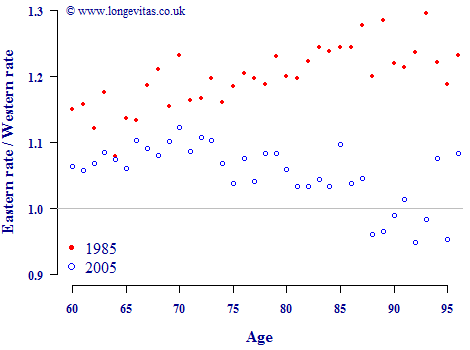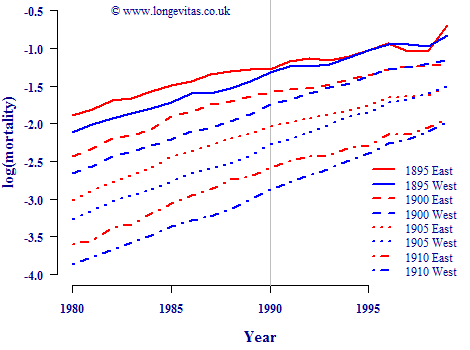East meets West
This month sees the twentieth anniversary of the fall of the Berlin Wall. This is therefore an appropriate time to remind ourselves of a dramatic example of the plasticity of mortality. This is the ability of mortality rates to change quickly in response to a new environment, particularly decreases in mortality.
The sudden and unexpected reunification of the two halves of Germany in 1989 provided demographers with an interesting sort of social experiment. As Scholz and Maier (2003) put it:
Prior to 1945 East and West Germans shared a cultural and historical background that included the political system. Between 1949 and 1989, however, Germans lived under two different political and economic systems: a socialist planned economy [...] versus a free-market democracy [...] With German unification in 1990 the two German populations were integrated again into one political and economic system.
Scholz and Maier (2003), introduction
In other words, a population was artificially separated for four decades under two very different systems, then suddenly reunited under a common system again. This is about as close as one can come to a controlled experiment on human mortality without violating ethical constraints. Reunification meant a levelling up of pension benefits in the East, and there was an interesting effect on post-retirement mortality. Figure 1 shows the ratio of East Germany mortality to West German mortality five years before reunification and fifteen years after.
Figure 1. East German mortality rates as ratio of West German rates in 1985 and 2005. Male mortality ratios calculated from data at Human Mortality Database.

Mortality rates of the elderly were clearly very much higher in East Germany than in the West. Figure 1 shows that this excess actually increased with age (solid red dots for 1985). The interesting feature for this article is how this excess managed to reduce dramatically over two decades: above age 85 there is a 20% fall in the ratio. This might not seem too remarkable until one remembers that West German mortality rates were falling as well over this period — East German rates were catching up on a moving target. Another way of looking at this is to plot the log mortality rates for selected birth cohorts and observe the convergence in mortality rates after reunification. This is done in Figure 2, which actually suggests that the convergence has been faster for the oldest ages.
Figure 2. Log(mortality) for selected birth cohorts of women in East and West Germany. Data provided by Scholz und Maier (2003).

This has an important implication for annuity portfolios and defined-benefit pension schemes: if the social and political system changes to grant extra resources to the elderly, be it in the form of higher pensions or better medical care, then mortality rates for even the very oldest can quickly fall by large amounts.


Add new comment